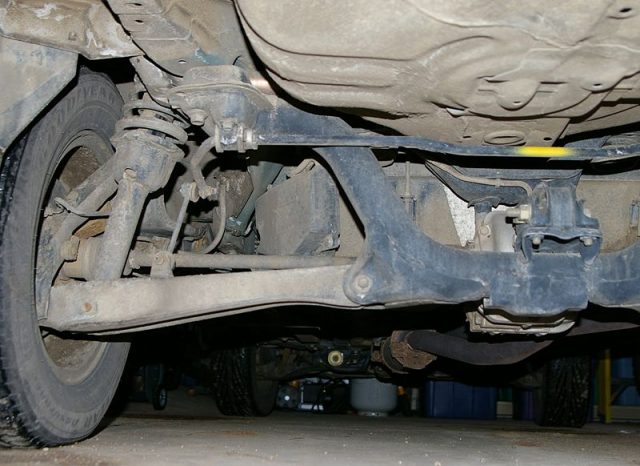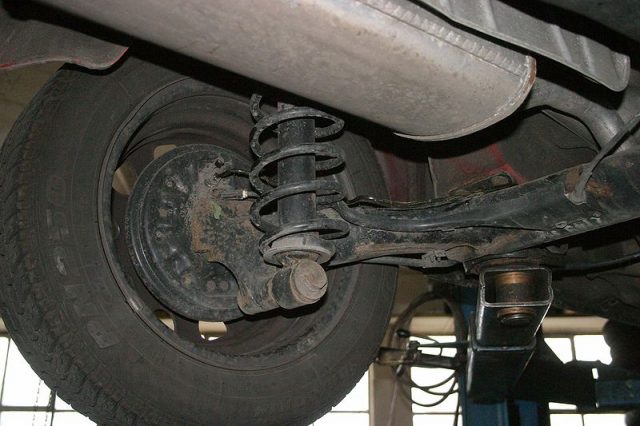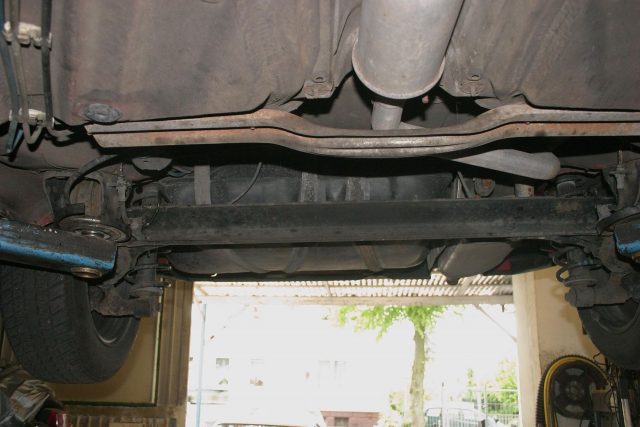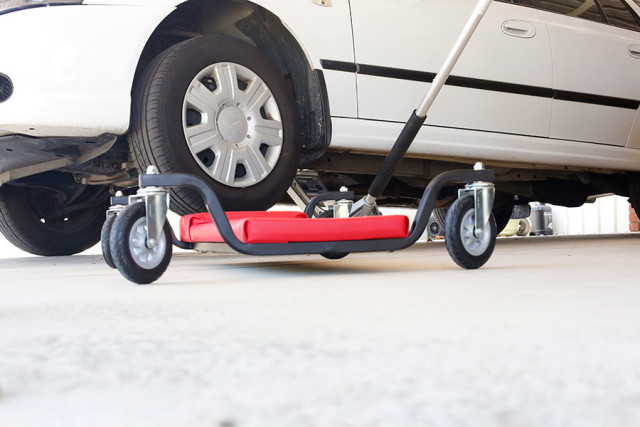When carrying out car inspections after an accident, suspension damage is not always apparent, even though it’s a common result. A good car mechanic will make sure that it is identified and repaired so that it won’t cause any further harm or costly repairs for you in the future. If the suspension components are bent, broken or misaligned this can cause a vehicle to handle poorly. It will also cause excessive tire wear and poor fuel economy.
Newer vehicles present the same type of problems with front or rear-end impacts. Manufacturers have specifications for rear wheel alignments now, so if those rear components are misaligned or broken they can affect the handling of the car, wear the tires abnormally and result in more fuel consumption.
Shiny and new? Maybe not.
In most car repair companies, estimates are done on the basis of a visual inspection and unless the suspension is visibly out of place or removed from the vehicle, it can be overlooked until later in the process. The car owner will generally give an account of how the damage came about, photos will be taken on the spot, and in his mind once the car looks shiny and new again, the work must be done? Right? Not necessarily. Modern car repair is more scientific than just hammering the dents out, checking that there are no leaks and spinning the tires. When the car arrives to the body shop, information is often inputted into a computer to generate an estimate for the repair, but sometimes certain damage doesn’t show up until after disassembly, creating a problem for both the garage and customer.
If a vehicle is involved in a collision, regardless of where the impact is most visible, it is highly likely that the front or rear suspension components will at least have sustained some kind of damage. These components don’t always show outward signs of damage so it can be quite hard to diagnose from the initial inspection. Often mechanical problems are only discovered towards the end of the repair process, when they are attempting to align the car. Suddenly, delivery time seems way off the initial estimate, and the customer is frustrated at the delay.
Estimate vs Actual
You’re probably shaking your head in agreement, because we’ve all been there. Unfortunately, the majority of auto repair places in Perth haven’t changed their methods to address this, which could be easily solved by a thorough examination and diagnosis the day the vehicle arrives in the garage.
Surprisingly, it is actually easy to quickly and accurately make a diagnosis of the damage to a suspension component in a few simple steps. To take the mystery out of it, let’s consider the basic suspension components of a car and how they are constructed.
How it Works
Better damages estimates can be made when the mechanics have a thorough understanding of how the suspension components are typically constructed and how they function. Although the suspension system is not the most vital part of the car, unlike, for instance, the engine, it does have a large affect on how comfortable and easy the car is to drive. Think of the word “suspension” in another context and you’ll likely imagine a bridge of some sort. In your car, the suspension system acts as a bridge between the car, you and the road beneath you.
Think about how you feel when you drive different types of vehicles. Some people prefer to take corners more tightly, even when feeling any unevenness. These are usually in sporty, lower set cars. Others who have to navigate harsh terrain regularly may want something that’s more comfortable such as an SUV or 4×4. These are all dependent on the suspension. The role of the car suspension is maximising the friction between tires and the road’s surface and to provide steering stability to the driver. This “bridge” suspends the frame of the vehicle above the wheels so that the body is aligned and the power is controlled, allowing you to experience a smoother ride. It is the difference between you feeling like you’re sliding along the road yourself with just a sliver of metal in between, and feeling safely enclosed in your comfortable car.
In an accident, if one component is damaged this can affect your steering and feeling of stability. Here, we consider the suspension components as various basic control functions that help drive/move the vehicle, stabilise or smooth your ride and of course, help steer the vehicle correctly. We talk about front and rear suspension, as most motorised vehicles have both and they involve different variants of the basic three suspension functions.
Front Suspension
Although rear-wheel drive vehicles have been the most popular overall historically, front-wheel drive vehicles have been produced more regularly in the past 80 years or so, starting with the Cord in the 1930’s. The McPherson Strut is the most widely used front suspension system because of its effective, efficient design. In more recent years, rear-wheel drive vehicles are mostly luxury cars or trucks. The main major difference between a standard front suspension and a front-wheel drive suspension is the location of the drive axles, which will be located in the front of the car.
The front suspension of most vehicles engages all three features of the basic suspension functions. They are used to steer, move the vehicle forward and also to stabilise or ensure a smooth ride for the passengers within the vehicle. There are, of course, a number of variations on the front suspension component, particularly in a rear-wheel drive system, but in order to make it simple, we’re discussing the most conventional unites here.
There are several main components that the suspension assembly comprises in a typical rear-wheel drive front suspension, these are:
- The drive axels
- Upper and lower control arms
- Hub, bearing and knuckle
- Strut or shock absorber
Sometimes this assembled unit is referred to as a knee assembly. If your front suspension has been badly damaged in an accident, sometimes it’s recommended to replace this entirely. You can buy a used knee assembly, just make sure that you are getting good advice and know where it has come from.
Rear suspension
Originally favoured in American-designed cars, rear suspensions are cheap to manufacture and operate very simply. Just like the front suspension, the rear suspension can serve the three basic functions of suspension, so the components can be very similar. In modern vehicles there can be many variances to rear suspensions though – ranging from basic to complex, such as Ford’s Control Blade. However, since we are keeping it simple – the basic components of a rear suspension are:
- Axle
- Axle housing
- Hub and bearings
- Shocks/struts
- Upper and lower control arms.
This may seem complex to the everyday car owner, who simply has their vehicle to get from A to B, but detecting damage to any one of these components is actually a relatively simple task, especially for a skilled mechanic. The three main things to remember when making a diagnosis are to inspect, measure and document.
The materials used to construct suspension components are usually aluminium, forged steel or cast steel, which prove difficult, if not impossible to repair. Thus, it’s always better to replace the damaged part with a new one, and never recommended to try and straighten bent suspension components.
So now we have the basics, what’s the best way to make an informed diagnosis and estimate? These simple steps give you a general guideline to the process from collision to repair.
Step 1: EXPLAIN THE PROCESS
One of the first things to do is explain to the customer that in order to provide a realistic estimate, the vehicle examination will take some time. If they are in a hurry or have to leave, they need to be aware that both you and they don’t have a clear picture and this can cause both delays and extra costs later on. Most customers are pretty understanding when you explain the process to them, and they’ll appreciate you being upfront. In an ideal world, they could get their estimate without leaving their car, but technology hasn’t developed to the point where the car can tell us what’s wrong yet!
Step 2: VISUAL INSPECTION
A quick tip to assess whether the suspension has been damaged is to measure the wheelbase on either side of the car. Use a tape measure or tram gauge to do this and if there is a difference in the measurements of both sides, then it’s highly likely that further investigation is going to unearth some suspension damage.
If the collision has impacted the wheel directly, make sure to check the front suspension for damage. If the car left the road during the accident or if you can see any visible damage to the front of the car, this is a fairly good indicator that you will find damage to the front suspension.
The vehicle will need to be elevated so that you can gain access to the suspension and check for damage. Wheels and tires should also be removed, so that they aren’t obscuring the view of the axle or axle housing.
Once you have a clear, unobstructed line of vision of the entire suspension frame, provided there are no dangerous parts hanging off or immediate hazards, begin inspecting the knuckle for signs of damage. Any flaking on steel components can indicate damage as they are often coated or painted. Stress cracks are a clear sign that something is wrong.
Next, take a look at the suspension mounting points. Examine the struts and shocks for any punctures, leaks or even slight bends where there shouldn’t be. A collision can cause shocks to bend quite easily. If you do see any damage to the shocks or struts, these will need replacing, as they can’t be repaired. On front-wheel drive vehicles, check for movement around the bolt holes.
Check drive axels for tears in the dust covers over the constant velocity (CV) joints. Two CV joints are located on each axle shaft. If there has been any frontal impact, pay particular attention to these areas. Similar to a U-joint, any grit or grime that gets into the joint can erode it to the point of needing replacement. If you have any concerns during the visual inspection, take note to have it tested at a professional axle fabrication company at a later date. Perhaps you already have a relationship with one and they will come to assess the damage for you.
Step 3: MEASURE AND DOCUMENT
Your garage or auto repair shop likely has a wide selection of vehicle manufacturer’s guides and frame spec books so you can compare the measurements you take with the norm. Some also have access to a mechanical estimating tool or system. Using a tram gauge or tape measure you can check that the vehicle matches the established reference points and determine whether there is any damage from this. Take photos of any variations and take notes as you go along. Although there is some tolerance listed by manufacturers, the mounting of suspension components is fairly exact, so even slight disparities can cause major issues in the drivability and safety of the vehicle.
It’s always a good back up to have proof of the damage and your notes to support your case for necessary repairs. This provides factual info and visual evidence of the car in its ‘before’ condition.
If you’re unsure yourself about any part of your diagnosis, make sure your mechanic is present whilst you’re examining the car. They will be able to inform you of base costs so you’ll have a good reference when writing your estimate. Although an estimate is guessing by definition, you should be writing a comprehensive list for repairs that has a price at least close to what the total will be.
Perform a thorough inspection and you’ll be better placed to provide the customer with an accurate estimate, but always remind the customer that your job is to repair the vehicle, not write the estimate. You want your customers to be happy, to recommend you to others and to return to use your service so if you’ve followed all the steps, their satisfaction will be obvious.
Taking the time to diagnose suspension damage can save you time in the long run and it’s not difficult to learn. Take some manufacturer training or certified courses with a regional or national body and it will pay dividends in your future.
If you’d like to know more about expert inspections, Spot On Vehicle Inspections cover most areas of Perth. Call today on 040 193 506 for a fast, friendly service at a reasonable price.




